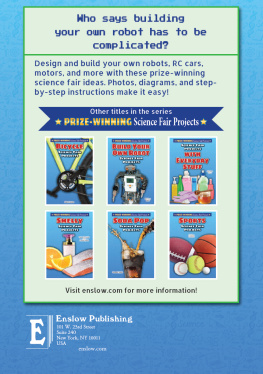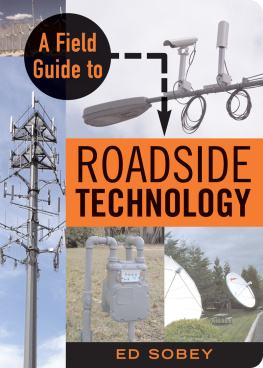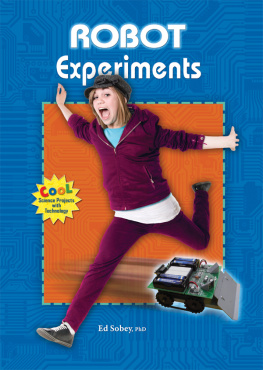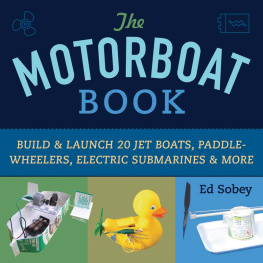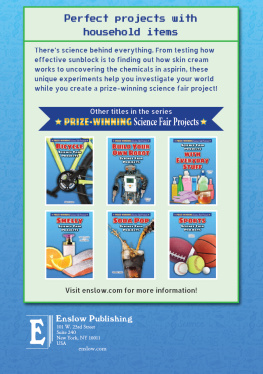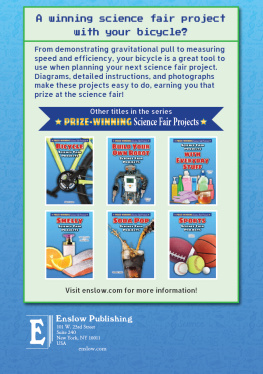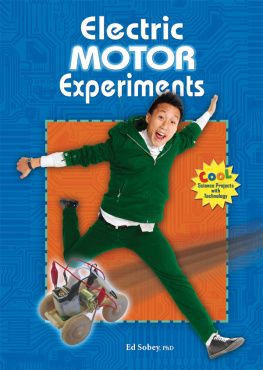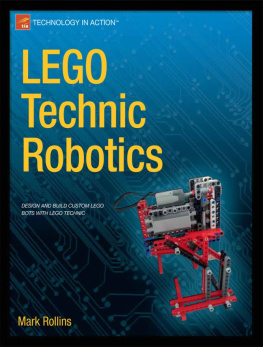Ed Sobey - Build Your Own Robot Science Fair Project
Here you can read online Ed Sobey - Build Your Own Robot Science Fair Project full text of the book (entire story) in english for free. Download pdf and epub, get meaning, cover and reviews about this ebook. year: 2015, publisher: Enslow Publishing, LLC, genre: Children. Description of the work, (preface) as well as reviews are available. Best literature library LitArk.com created for fans of good reading and offers a wide selection of genres:
Romance novel
Science fiction
Adventure
Detective
Science
History
Home and family
Prose
Art
Politics
Computer
Non-fiction
Religion
Business
Children
Humor
Choose a favorite category and find really read worthwhile books. Enjoy immersion in the world of imagination, feel the emotions of the characters or learn something new for yourself, make an fascinating discovery.
Build Your Own Robot Science Fair Project: summary, description and annotation
We offer to read an annotation, description, summary or preface (depends on what the author of the book "Build Your Own Robot Science Fair Project" wrote himself). If you haven't found the necessary information about the book — write in the comments, we will try to find it.
Design and build your own robots, RC cars, motors, and more with these prize-winning science fair ideas!
Build Your Own Robot Science Fair Project — read online for free the complete book (whole text) full work
Below is the text of the book, divided by pages. System saving the place of the last page read, allows you to conveniently read the book "Build Your Own Robot Science Fair Project" online for free, without having to search again every time where you left off. Put a bookmark, and you can go to the page where you finished reading at any time.
Font size:
Interval:
Bookmark:

To A. C. Gilbert, a man whose toys inspired generations of engineers, inventors, and scientists, including me
Published in 2016 by Enslow Publishing, LLC
101 W. 23rd Street, Suite 240, New York, NY 10011
Copyright 2016 by Ed Sobey, Ph.D.
All rights reserved.
No part of this book may be reproduced by any means without the written permission of the publisher.
Cataloging-in-Publication Data
Sobey, Ed.
Build your own robot science fair project / by Ed Sobey, Ph.D.
p. cm. (Prize-winning science fair projects)
Includes bibliographical references and index.
ISBN 978-0-7660-7018-9 (library binding)
1. Robotics Juvenile literature. 2. Science projects Juvenile literature. I. Sobey, Edwin J. C.,
1948-. II. Title.
TJ211.2 S63 2016
629.892d23
Printed in the United States of America
To Our Readers: We have done our best to make sure all Web site addresses in this book were active and appropriate when we went to press. However, the author and the publisher have no control over and assume no liability for the material available on those Web sites or on any Web sites they may link to. Any comments or suggestions can be sent by e-mail to .
Portions of this book originally appeared in the book How to Build Your Own Prize-Winning Robot.
Illustration Credits: Stephen F. Delisle with modification by Accurate Art, Inc. c/o George Barile.
Photo Credits: Ed Sobey except bbbb/.
Cover Credits: bbbb/Shutterstock.com (robot); Ohn Mar/Shutterstock.com (science background).
CONTENTS
Acknowledgments
Introduction
CHAPTER 1 Learn About Robots
 PROJECT 1: Building a Motorized Model Boat
PROJECT 1: Building a Motorized Model Boat
 PROJECT 2: Building a Motorized Model Car
PROJECT 2: Building a Motorized Model Car
CHAPTER 2 Learn About Electric Motors
PROJECT 3: Taking a Motor Apart
 PROJECT 4: Measuring Voltages with a Voltmeter
PROJECT 4: Measuring Voltages with a Voltmeter
PROJECT 5: Measuring Voltage Drops and Current
CHAPTER 3 How to Modify Servos
PROJECT 6: Hacking the Servos
CHAPTER 4 Add Some Wheels
PROJECT 7: Attaching the Motors to the Wheels
CHAPTER 5 Build a Robot Platform
 PROJECT 8: Building the Platform
PROJECT 8: Building the Platform
PROJECT 9: Attaching the Wheels and Motors to the Platform
PROJECT 10: Attaching the Circuit Board
CHAPTER 6 Supply Electrical Power
PROJECT 11: Series and Parallel Circuits
CHAPTER 7 Control the Robots Motion
PROJECT 12: Wire the Circuit Board
PROJECT 13: Running Servos with a Stamp Chip Experiments with a symbol feature PROJECT Ideas and Further Explorations.
PROJECT 14: Moving the Robot in a Straight Line
PROJECT 15: Completing the Square
CHAPTER 8 What Else Can the Robot Do?
CHAPTER 9 Robot Competitions and Science Fair Projects
Appendix A: Robot Kits and Supplies
Appendix B: Other Approaches to Robotics
Appendix C: Robotics Clubs and Organizations
Further Reading
Web Sites
Index
ACKNOWLEDGMENTS
Several robot professionals and avid hobbyists helped with technical details. Gene Elliott and other members of the Seattle Robotics Society provided references and background information.
Ken Gracey of Parallax contributed components I used to build model robots.
Texas BEST, Texas A&M University, and Texas Instruments invited me to their robot competition and inspired this book. Thank you, gracious hosts.
I am deeply indebted to Ted Mahler, cofounder of BEST and design engineer for Texas Instruments, for reviewing the manuscript and giving valuable suggestions.
Most of the photos were taken at robot camps and classes, especially Kids Invent Robots.
INTRODUCTION
Robots are a hot topic everywhere. Autonomous automobiles are now driving the streets and robotic helicopters are snapping photos from the sky. Some companies are developing parcel delivery services run by robots or robot-like devices. The greatest change in the field of robots is that the technology is now accessible and affordable. You can build robots, and this book will be your starting point.
Robotics involves electronics, mechanical systems, computers, and a variety of materials. This book will guide you through the most important elements of these fields. The starting point is getting you familiar and comfortable with electric motors and motor control.
Each chapter will give you information you need to build your robot, as well as specific examples and projects. , you can follow the projects from chapter to chapter using the suggested materials to make your own robot. You may, however, choose to create an original robot using different components from electronics, model, and robot stores. The Project Ideas and Further Exploration sections will give you ideas for different robot options.
As much as we hope you will enjoy reading about robots, we urge you to make one. Or make two. Learning is in the making, and you will learn so much while making your robot work the way you want it to.

At the 2012 World Robot Olympaid in Malaysia, these students watch their robots play soccer using programmed responses.
The Scientific Method
When you do a science project, especially one with your own original research, you will need to use what is commonly called the scientific method. In many textbooks you will find a section devoted to the subject. The scientific method consists of a series of steps.
1.Come up with a QUESTION or try to solve a PROBLEM. What are you curious about? What could your robot do?
2.RESEARCH your topic. Find out what is already known. Has anyone already answered your question or solved your problem? What facts are published about your topic?
3.Form a HYPOTHESIS, which is an answer to your question or a solution to your problem.
4.Design an EXPERIMENT to test your hypothesis. Collect and record the data from your experiment.
5.Study your experimental RESULTS and form a CONCLUSION. Was your hypothesis true or false?
6.REPORT your findings.
Safety First
Always follow these safety rules while working on your robots.
Do not use electric current from a wall or floor outlet except for devices that have been tested and approved.
Do not point sharp tools toward yourself or others.
Protect your eyes with glasses or safety goggles.
Get adult help before using any power tools or gasoline motors.
This book will launch you into designing and building your own robots. Have fun and be safe.
Chapter 1
LEARN ABOUT ROBOTS
Robots have invaded Hollywood. WALL-E, Chappie, and Johnny 5 joined R2-D2 and C-3PO from the Star Wars movies as modern heroes. But you cant rush out to buy one of these marvelous machines, you will have to make one.
Real robots are unlike the ones you see in the movies. Most of the movie robots arent robots at all. What makes a machine a robot?
To be a robot, a machine has to meet three criteria. First, it has to do mechanical work. That is, it must be able to move itself or move something else. So a computer is not a robot. In a factory, robots most often retrieve parts and put them where they are needed to assemble something. Sometimes they weld parts together. Other robots operate spray painters. Whatever else it does, a robot moves.
Font size:
Interval:
Bookmark:
Similar books «Build Your Own Robot Science Fair Project»
Look at similar books to Build Your Own Robot Science Fair Project. We have selected literature similar in name and meaning in the hope of providing readers with more options to find new, interesting, not yet read works.
Discussion, reviews of the book Build Your Own Robot Science Fair Project and just readers' own opinions. Leave your comments, write what you think about the work, its meaning or the main characters. Specify what exactly you liked and what you didn't like, and why you think so.

